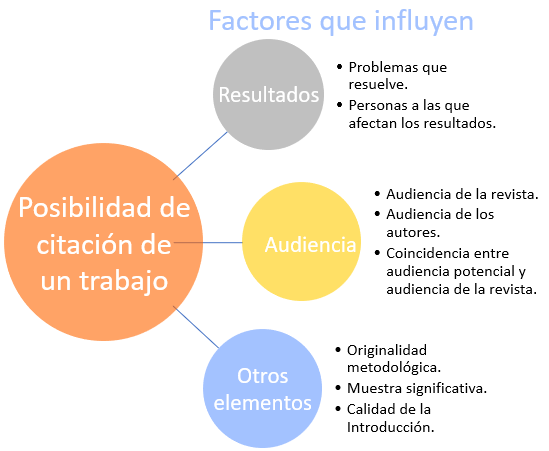Author: Rafael Repiso – Translation: Erika-Lucia Gonzalez-Carrion
Why do you cite a research work?
Basically because it has something to contribute, therefore, the basis of everything is the originality and quality of the work. However, the nature of the work is useless if it is not read by anyone. Using the metaphor of energy, we can say that the works are the fuel, the readers who will take advantage of that work are the fuel and the magazines are the catalyst, which accelerates or slows down this relationship without participating directly in it. The result, the energy, would be the quotes. Therefore and roughly, if you want your work to be read and quoted by the largest number of people, you need it to be of quality and at the same time to be able to approve the demands of a scientific journal that has a large audience of researchers interested in the subject matter of the work.

If we want to guess the possibilities that a work has of being cited we must take into account the number of novel elements (and quality) that the work brings and put it in relation to the audience of this one. The novel aspects have to do mainly with the results, but there are other important elements such as having a novel methodology, an interesting sample or a rich and attractive introduction. All these elements can be separate reasons for a work to receive quotations.
Likewise, potential readers (and future citation recipients) are not limited to the audience of a journal, but the authors themselves have an audience that overlaps to a greater or lesser degree with that of the other co-authors, depending on the aspects shared. Therefore, international collaboration is also an element that increases the chances of a paper being cited.
Seeing that the factors that influence the frequency of citation were many and diverse and affect this objective to a greater or lesser extent, Alicia Moreno-Delgado, Ignacio Aguaded and myself decided to publish a work that is somewhat more extensive than a simple post and on the way to inaugurate a journal that is called to be a reference in the studies of Ibero-American Bibliometrics. Therefore, we recommend the following reading if the reader is still interested in going deeper into the different factors that affect whether a work is cited or not. Repiso, R., Moreno-Delgado, A., & Aguaded, I. (2020). Factors that influence the frequency of citation of an article. Iberoamerican Journal of Science Measurement and Communication, 1(1). LINK http://eprints.rclis.org/40292/1/Opinion%20Paper%202_Spanish.pdf
